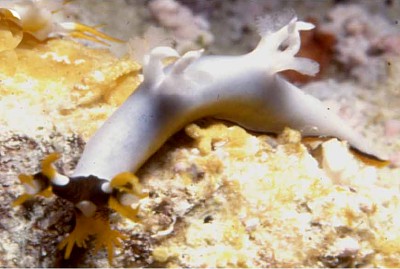
Bornella irvingi
Edmunds & Preece, 1996
Order: NUDIBRANCHIA
Suborder: DENDRONOTINA
Family: Bornellidae
DISTRIBUTION
Known only from the original description from the Pitcairn Islands , SE Pacific Ocean.
PHOTO
Ducie Atoll, Pitcairn Islands, 12-15 m deep under coral slab. 24 October 1991. Photo: J. Jamieson. [with permission of R. C. Preece].
The body is white except for the head which is black, back to just behind the base of the rhinophores. The edge of the foot is described as having an orange margin and a submarginal black band, neither of which are visible in the accompanying photo. The rhinophore sheath has a three papillae around the upper edge and a large posterior papilla originates halfway up the sheath. The sheath is black and the three terminal papillae are orange. The basal half of the long posterior papilla is white while the upper half is orange. The rhinophores are translucent white. The hand-like digitate oral lobes are orange. There are two pairs of dorso-lateral mantle processes and emerging from the outer base of each process are a pair of gills.
The only specimens found have been small, 11 and 16 mm long preserved.
-
Edmunds, M. & Preece, R. (1996) A collection of opisthobranch mollusks from the Pitcairn Islands. Journal of Conchology, 35, 407–420.
-
Pola, M., Rudman, W. B. & Gosliner, T. M. (2009) Systematics and preliminary phylogeny of Bornellidae (Mollusca: Nudibranchia: Dendronotina) based on morphological characters with description of four new species. Zootaxa, 1975, 1-57.
Rudman, W.B., 2009 (January 23) Bornella irvingi Edmunds & Preece, 1996. [In] Sea Slug Forum. Australian Museum, Sydney. Available from http://www.seaslugforum.net/factsheet/bornirvi
